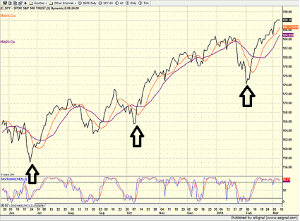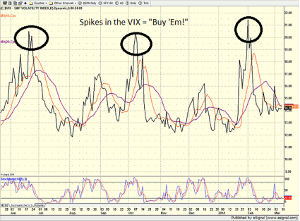David Moenning of StateoftheMarkets.com shares the details of how traders can use the spikes in the Vix to identify optimal entry points in the stock market.
Before we were so rudely interrupted by all the hullabaloo surrounding Ms. Yellen's definition of a "considerable" amount of time (now known to be six months), we were looking at how the VIX could be used to help identify decent entry points for traders looking to get long the US stock market. And since the market still appears to be trying to make up its mind which way things will go from here, this appears to be as good a time as any to expand on the idea of using the VIX to "buy the freaking dips."
As we discussed earlier in the week, a simple (okay, really simple) approach to identify turning points in the market after a correction is to wait for the VIX to first spike and then reverse lower.
Below are the charts we used as Exhibit A. No, this is not a sophisticated approach. But hey, it DOES seem to do a decent job.
S&P 500 Daily
VIX Daily
If you will recall, at the end of the last report, we promised to apply some fancy math to this approach to see if we couldn't come up with a more consistent, more quantifiable way to use the VIX to help you BTFD. So here goes.
But First, Some Caveats
Before we get started, there are a couple caveats worth noting. First, it is important to recognize that the character of the stock market has changed over the last few years. Blame it on Virtu, Getco, Citadel, Goldman, or JPMorgan and their algos if you'd like. But there should be little argument that both the volatility and the speed with which moves now occur have increased.
Next, too many investors believe that all stock market indicators produce strong buy AND sell signals. This is simply not true. Some indicators provide excellent buy signals but lousy sell signals, and vice versa. So, please don't think that any single indicator can provide you with accurate signals to move in and out of the markets. In this case, we are looking at only the buy side of the indicator—for good reason.
Finally, it goes without saying that investors should never use any indicator in a vacuum. No, the game is a wee bit harder than that. The trick is to find a quiver full of weapons to use, and then now which arrow to use and when.
NEXT PAGE: Details of the Signal
|pagebreak|Our VIX Buy Signal
With the necessary disclosures and disclaimers out of the way, let's get to our buy signal. The idea is to use the VIX and its 20-day moving average. Simple enough, right? Next, we need to calculate the number of standard deviations the VIX is from its 20 dma. A little tougher, but a quick Google search should do the trick.
So, when the VIX first moves more than two standard deviations from the 20-day, and then reverses below the two standard deviations line, a buy signal is flashed.
In English, what this tells us is that the market has experienced a correction and a corresponding spike in the VIX. Then, when the VIX moves back below the two standard deviation line, it tells us that volatility is retreating. This, in turn, means that the correction in stock prices may have run its course.
The Stats
Since 2011, there have been 21 "initial" buy signals given. Note that this indicator often produces "double-barreled" buys as the VIX oftentimes spikes, retreats, and then spikes again. For our purposes, we are using only the first buy signal.
Of those 21 buy signals, 17 have led to higher prices in the ensuing weeks on the S&P 500. If my calculator is correct, this means that when our VIX buy signal occurs, the odds of success are 81%. Not bad, eh?
Looking at the stats back to 1995, five days after an initial buy signal, the average gain on the S&P is +0.27%, which is exactly 50% better than the average gain of +0.18% for all five-day periods.
Two weeks after the buy signal, the gains in the market are again about 50% better than average (+0.53% vs. +0.35%). And four weeks later, the S&P's average gain has been +1.11%, which is 61% better than the average gain of 0.69% for all 20-day periods.
When eye-balling the chart of this indicator, it is clear that this indicator has been quite good over the past two years. In short, the buy signals have consistently provided investors with very good opportunities to BTFDs.
The Latest Signal
The latest buy signal was flashed on March 17, 2014 (the one before that occurred at the end of January). So, while there are never ANY guarantees at all in this business, this indicator does seem to tell you that the odds favor the bulls for the next few weeks.
To be sure, the recent dip wasn't much, and of course, there is a chance that it isn't over. However, our VIX signal did flash an initial buy. And with 81% odds, you couldn't be blamed for buying this little dip.
By David Moenning of StateoftheMarkets.com























